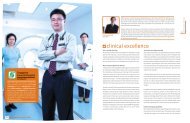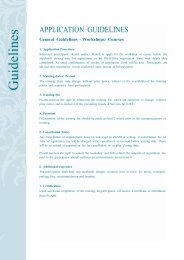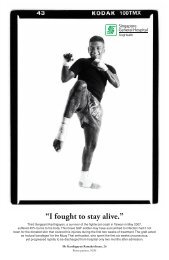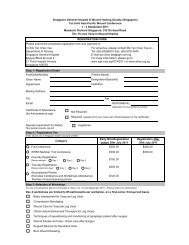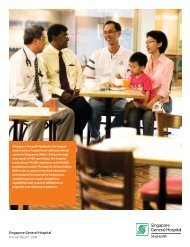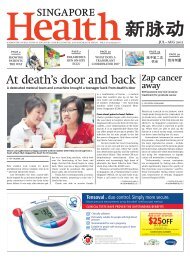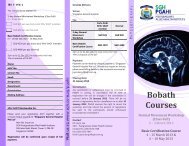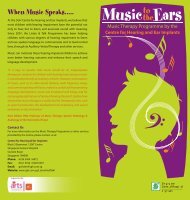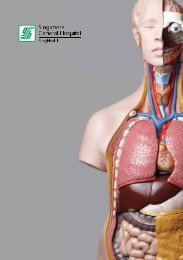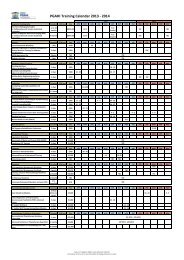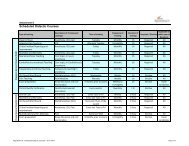basic cardiac life support (bcls) programme - Singapore General ...
basic cardiac life support (bcls) programme - Singapore General ...
basic cardiac life support (bcls) programme - Singapore General ...
Create successful ePaper yourself
Turn your PDF publications into a flip-book with our unique Google optimized e-Paper software.
BASIC CARDIAC LIFE SUPPORT (BCLS)<br />
PROGRAMME<br />
Institute for Medical Simulation & Education
DO’s<br />
SAFETY IN<br />
CPR TRAINING<br />
• Wash your hands or use handrub before<br />
and after manikin contact.<br />
• Disinfect manikin’s mouth and nose<br />
with 70% methylated spirit after each<br />
participant’s contact.<br />
• Use a disposable face shield when<br />
performing mouth-to-mouth ventilation.<br />
• Inform the staff of the training centre if<br />
you have :<br />
– Wet skin rashes on your hands, in your<br />
mouth or around your lips.<br />
– Hepatitis B.<br />
– An upper respiratory infection.<br />
– Medical problems e.g. heart, asthma or<br />
orthopaedic problems.<br />
• Disinfect manikins after each practical<br />
session following guidelines provided by<br />
the training centre.<br />
C o n t e n t s<br />
Module 1 InTRODUCTIOn 2<br />
Module 2 The Chain of Survival 3<br />
Module 3 The hEART 4<br />
3.1 Anatomy & Function<br />
3.2 Heart Attack<br />
3.3 Risk Factors of Heart Attack<br />
3.4 Prudent Heart Living<br />
Module 4 ADULT CARDIO-PULMONARY RESUSCITATION (CPR) 9<br />
4.1 Definition<br />
4.2 Steps of Adult One-Man CPR<br />
4.3 Adult Two-Man CPR<br />
4.4 Steps of Adult Two-Man CPR<br />
4.5 Steps for Switching of Roles<br />
Module 5 ADULT RECOVERY POSITION 22<br />
Module 6<br />
ADULT FOREIGN BODY AIRWAY<br />
OBSTRUCTION (FBAO) 25<br />
6.1 Introduction<br />
6.2 Recognition of FBAO<br />
6.3 Relief of FBAO in the Conscious Adult<br />
6.4 Relief of FBAO in the Unconscious Adult<br />
Module 7 INFANT CARDIO-PULMONARY RESUSCITATION (CPR) 31<br />
7.1 Introduction<br />
Module 8 INFANT RECOVERY POSITION 39<br />
BCLS Programme<br />
DONT’s<br />
• Do not eat or drink during practical<br />
training to avoid contamination of<br />
manikins with food particles.<br />
• Do not use pen to mark any area of the<br />
manikin.<br />
• Do not attempt to force the manikin’s<br />
mouth open beyond 2.5cm.<br />
• Do not use lipstick if practising on the<br />
manikin.<br />
• Do not perform or practise chest<br />
compression on a victim with a pulse,<br />
practise only on a manikin.<br />
Module 9<br />
INFANT FOREIGN BODY AIRWAY<br />
OBSTRUCTION (FBAO) 41<br />
9.1 Introduction<br />
9.2 Relief of FBAO in the Conscious Infant<br />
9.3 Relief of FBAO in the Unconscious Infant<br />
Module 10 APPLICATION OF POCKET MASK 47<br />
Module 11 SUMMARY CHECKLIST 51<br />
Copyright © 2007<br />
Produced by Life Support Training Centre, SGH<br />
All rights reserved.<br />
No part of this publication may be reproduced, stored in a retrieval system or transmitted, in any form or by any means,<br />
electronic, mechanical, photocopying, recording or otherwise, without the prior permission of the copyright owner.<br />
BCLS Programme<br />
1
Module 1<br />
InTRODUCTIOn<br />
Module 2<br />
The Chain of Survival<br />
In <strong>Singapore</strong>, heart disease is the second commonest cause of death, being responsible<br />
for about 24% of total mortality. About 2,400 persons develop an acute heart attack in<br />
<strong>Singapore</strong>. In addition, nearly 1000 people suffer from sudden <strong>cardiac</strong> arrest in the outof-hospital<br />
environment and another few hundred sustain sudden <strong>cardiac</strong> arrest after<br />
reaching hospital. The total survival rate for the group of pre-hospital collapses is about<br />
2.6%.<br />
The concept of “Chain of Survival” is the best approach to the treatment of victims<br />
in <strong>cardiac</strong> arrest. The four links in this chain are: Early Recognition and Access to<br />
Emergency Care, Early CPR, Early Defibrillation and Early Advanced Cardiac Care.<br />
Public education and training in Cardio-Pulmonary Resuscitation (CPR) are crucial in<br />
reducing “sudden death” because the majority of these deaths occur out of hospital.<br />
One of the most startling ideas of modern medicine is that “sudden death” can be<br />
reversed. The actions taken during the first few minutes of an “Emergency” are critical<br />
to victim survival. It can be performed by any of us, anywhere. All that is needed is our<br />
two hands.<br />
REMEMBER:<br />
CPR can save lives.<br />
Do it well. Do it right.<br />
And the victim gets a chance at <strong>life</strong>.<br />
Early<br />
Recognition<br />
and Access<br />
Early<br />
CPR<br />
Early<br />
Defibrillation<br />
Early<br />
Advanced Care<br />
First Link : Early Recognition and Access<br />
Early recognition and access refers to shortening the time interval from onset of<br />
heart attack or <strong>cardiac</strong> arrest to arrival of a trained emergency care team. It includes:<br />
• recognition of early warning signs of heart attack e.g. chest pain, sweatiness,<br />
shortness of breath, nausea or vomiting<br />
• recognition of <strong>cardiac</strong> arrest e.g. unconscious, no breathing and no pulse or<br />
‘signs of circulation’<br />
• rapid call for the first response team<br />
• allowing ambulances priority on the roads so that they can reach the patient quickly<br />
• allowing paramedics rapid access and priority in use of elevators in high-rise<br />
buildings.<br />
BCLS Programme<br />
Second Link : Early CPR<br />
The brain starts dying within minutes when the heart stops pumping. CPR needs<br />
to be initiated as soon as possible to provide oxygen and blood flow to the brain and<br />
heart and remove excess carbon dioxide from the lungs. CPR cannot always re-start the<br />
heart. It can however buy the valuable time needed to keep the vital organs alive until<br />
definitive help arrives.<br />
BCLS Programme<br />
2<br />
3
Third Link : Early Defibrillation<br />
This procedure can frequently re-start the heart if carried out early. Studies have<br />
shown that early defibrillation is most likely to improve survival rates for out-ofhospital<br />
<strong>cardiac</strong> arrest patients. Every emergency vehicle transporting <strong>cardiac</strong> arrest<br />
patients should be equipped with a defibrillator. Defibrillation works best in the first<br />
few minutes after onset of <strong>cardiac</strong> arrest. If initiated too late, the heart will not respond<br />
to electrical therapy. For every minute of delay in delivering defibrillation following<br />
collapse, the survival rate decreases by 7 –10%.<br />
Fourth Link : Early Advanced Care<br />
Advanced Cardiac Life Support stabilises the resuscitated victim’s condition in the<br />
most critical phase. It consists of advanced airway management and administration of<br />
medication and is frequently carried out in the in-hospital environment.<br />
3.2 hEART ATTACK<br />
Heart attack usually occurs when a blood clot suddenly and completely blocks an<br />
already diseased coronary artery. Coronary artery disease is the end-result of a gradual<br />
build-up of fatty deposits (cholesterol plaques) and blood cells in the inner lining of the<br />
coronary arterial wall, a process also known as “atherosclerosis”. Over a period of years,<br />
this leads to gradual narrowing of the lumen of the vessel, thereby reducing blood flow<br />
to heart muscle. Occasionally, the surface of a plaque may split or crack, and attract<br />
blood clots, which then cause complete obstruction of the lumen, resulting in “heart<br />
attacks”.<br />
Right Coronary<br />
Artery<br />
Coronary Arteries<br />
Left Circumflex<br />
Artery<br />
Module 3<br />
The hEART<br />
Left Coronary<br />
Artery<br />
3.1 ANATOMY & FUNCTION<br />
The heart is a hollow, conical, muscular organ situated in the centre of the chest<br />
between the lungs and behind the sternum (breastbone). It is about the size of a<br />
clenched fist.<br />
Left Anterior<br />
Descending<br />
Artery<br />
BCLS Programme<br />
Rib<br />
Sternum<br />
Xiphoid<br />
process<br />
The Heart in Relation<br />
to the Chest<br />
Heart<br />
Superior<br />
vena cava<br />
Inferior<br />
vena cava<br />
The Heart as a Pump<br />
Right<br />
pulmonary artery<br />
Left<br />
pulmonary artery<br />
Left<br />
pulmonary<br />
veins<br />
It receives blood depleted of oxygen from all parts of the body and pumps it to the<br />
lungs. There oxygen is taken up and the oxygen-enriched blood returns to the heart to<br />
be distributed to all parts of the body. The coronary arteries are blood vessels that send<br />
oxygen-rich blood to the muscles of the heart.<br />
Symptoms of Heart Attack<br />
How to recognize a Heart Attack<br />
• Chest discomfort or pain is the most common symptom. It usually has the following<br />
characteristics:<br />
– uncomfortable pressure, squeezing, fullness, tightness, or pain.<br />
– usually located at the centre of the chest behind the breastbone.<br />
– may spread to either the shoulder, neck,<br />
lower jaw, or either arm and occasionally to<br />
the upper abdomen.<br />
– usually lasts longer than 20 minutes.<br />
• Other symptoms may include any or all of the<br />
following:<br />
– sweating<br />
– nausea (a feeling of wanting to vomit)<br />
– shortness of breath<br />
– weakness<br />
BCLS Programme<br />
4<br />
5
BCLS Programme<br />
• Symptoms may occur suddenly and not be typical, so that some victims may not<br />
realise that they are having a heart attack. They may also think that the problem is<br />
due to indigestion.<br />
If you meet anyone<br />
with these symptoms,<br />
arrange for immediate<br />
transportation to the<br />
nearest emergency<br />
medical facility by dialling<br />
995 for an emergency<br />
ambulance.<br />
Common Causes Of Sudden Death<br />
• Heart Attack<br />
• Foreign Body Airway Obstruction<br />
• Drowning<br />
• Stroke<br />
• Drug Overdose<br />
• Suffocation<br />
• Smoke Inhalation<br />
• Electrocution<br />
• Severe Allergic Reactions<br />
• Severe Trauma, e.g. Automobile Accident<br />
Photo Courtesy of SCDF<br />
Many of these deaths can be prevented if the victims get prompt help – if someone<br />
trained in CPR provides proper <strong>life</strong>-saving first-aid until other medical expertise take<br />
over.<br />
3.3 RISK FACTORS OF HEART ATTACK<br />
There are a number of well-recognised risk factors for a heart<br />
attack. All risk factors can be modified to decrease the chance<br />
of heart attack. The more risk factors are present, the greater the<br />
risk of having a heart attack.<br />
• Major risk factors that cannot be changed:<br />
– heredity<br />
– male gender<br />
– increasing age<br />
• Major risk factors that can be changed:<br />
– cigarette smoking<br />
– high blood pressure<br />
– high blood cholesterol levels<br />
– diabetes mellitus<br />
• Other risk factors that can be modified:<br />
– obesity<br />
– physical inactivity<br />
– stress<br />
3.4 PRUDENT HEART LIVING<br />
Prudent Heart Living includes adopting a <strong>life</strong>style to help<br />
minimise the risk of a future heart attack. Reducing risk factors<br />
lowers the chance of having a heart attack or stroke.<br />
• Control high blood pressure – treatment generally includes<br />
dietary change and medication. Take<br />
medication regularly as prescribed by your<br />
doctor.<br />
• Quit smoking completely.<br />
• Eat wisely – reduce saturated fat and<br />
cholesterol in the diet. Eat a Balanced diet.<br />
• Reduce weight if you are overweight –<br />
count calories in your food intake.<br />
• Exercise regularly – exercise tones the muscles, stimulates<br />
blood circulation, helps avoid excess weight gain and<br />
promotes a general feeling of well being.<br />
BCLS Programme<br />
6<br />
7


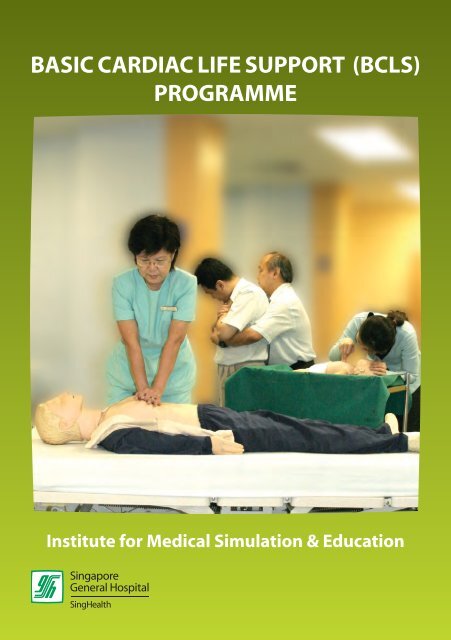
![help document [pdf]](https://img.yumpu.com/26291587/1/190x245/help-document-pdf.jpg?quality=85)
